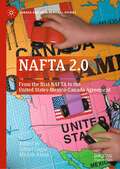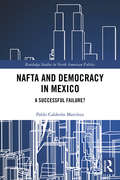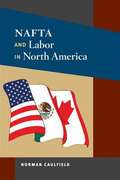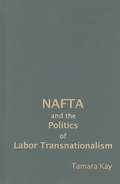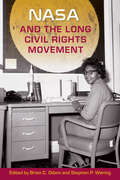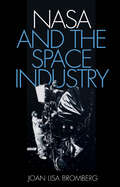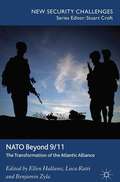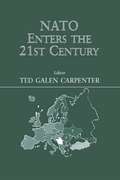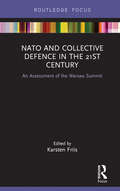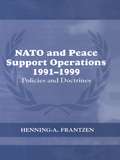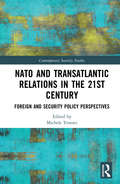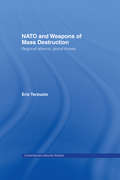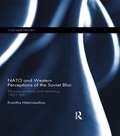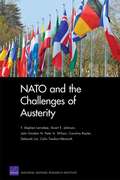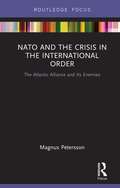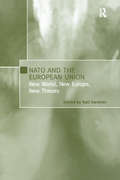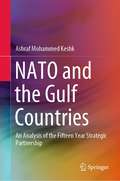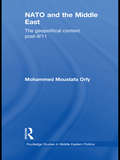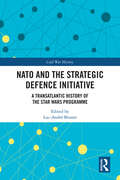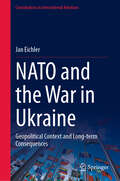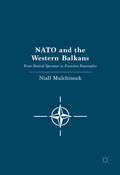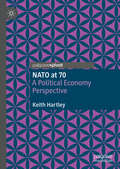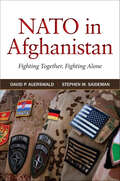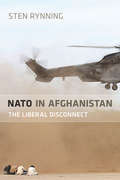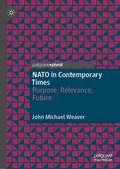- Table View
- List View
NAFTA 2.0: From the first NAFTA to the United States-Mexico-Canada Agreement (Canada and International Affairs)
by Michèle Rioux Gilbert GagnéThe renegotiation and possible termination of the North American Free Trade Agreement (NAFTA) sparked a lot of interest and concern in light of the United States’ declared objective to “rebalance the benefits” of the agreement. This edited book provides an overview of the changes brought to the NAFTA by the United States-Mexico-Canada Agreement (USMCA) or NAFTA 2.0. Grouping leading academics and experts from the three countries, the book covers the major topics in the transition from the NAFTA to the USMCA. The book also sheds light on the evolution of North American economic integration within the past three decades and reflects on the significance of the regional integration model represented by the NAFTA and now the USMCA. The book is aimed at scholars, students, officials, professionals and interested citizens concerned by the big issues surrounding North American integration and economic globalization.
NAFTA and Democracy in Mexico: A Successful Failure? (Routledge Studies in North American Politics)
by Pablo Calderón MartínezAfter describing NAFTA as ‘the worst trade deal maybe ever signed anywhere’, Donald Trump’s election seemed to represent the final nail in the coffin for North American economic integration. Following a decade of stagnation, however, Trump’s victory presents a timely opportunity to reconsider North American integration and evaluate NAFTA’s democratic track record in Mexico. In this book, Pablo Calderón Martínez presents a detailed analysis of NAFTA’s influence as a political tool for democracy in Mexico. Extending beyond a mere economic or social exploration of the consequences of NAFTA, Calderón Martínez uses a three-tiered analysis based on causality mechanisms to explain how the interactions between internationalisation and democratisation unfolded in Mexico. Calderón Martínez’s analysis demonstrates that Mexico’s internationalisation project under the framework of NAFTA gave shape to, if not made, Mexico’s democratisation process. An original and timely resource for scholars and students interested in understanding how – in cases like Mexico where transitions to democracy are characterised by a finely poised balance of power – small influences from abroad can make significant long-lasting differences domestically.
NAFTA and Labor in North America (The Working Class in American History)
by Norman CaulfieldAs companies increasingly look to the global market for capital, cheaper commodities and labor, and lower production costs, the impact on Mexican and American workers and labor unions is significant. National boundaries and the laws of governments that regulate social relations between laborers and management are less relevant in the era of globalization, rendering ineffective the traditional union strategies of pressuring the state for reform. Focusing especially on the effects of the North American Free Trade Agreement and the North American Agreement on Labor Cooperation (the first international labor agreement linked to an international trade agreement), Norman Caulfield notes the waning political influence of trade unions and their disunity and divergence on crucial issues such as labor migration and workers' rights. Comparing the labor movement's fortunes in the 1970s with its current weakened condition, Caulfield notes the parallel decline in the United States' hegemonic influence in an increasingly globalized economy. As a result, organized labor has been transformed from organizations that once pressured management and the state for worker concessions to organizations that now request that workers concede wages, pensions, and health benefits to remain competitive in the global marketplace.
NAFTA and the Politics of Labor Transnationalism
by Tamara KayWhen NAFTA went into effect in 1994, many feared it would intensify animosity among North American unions, lead to the scapegoating of Mexican workers and immigrants, and eclipse any possibility for cross-border labor cooperation. But far from polarizing workers, NAFTA unexpectedly helped stimulate labor transnationalism among key North American unions and erode union policies and discourses rooted in racism. The emergence of labor transnationalism in North America presents compelling political and sociological puzzles: How did NAFTA, the concrete manifestation of globalization processes in North America, help deepen labor solidarity on the continent? In addition to making the provocative argument that global governance institutions can play a pivotal role in the development of transnational social movements, this book suggests that globalization need not undermine labor movements: collectively, unions can help shape how the rules governing the global economy are made.
NASA and the Long Civil Rights Movement
by Brian C. Odom and Stephen P. WaringAmerican Astronautical Society Eugene M. Emme Astronautical Literature Award <p><p> As NASA prepared for the launch of Apollo 11 in July 1969, many African American leaders protested the billions of dollars used to fund “space joyrides” rather than help tackle poverty, inequality, and discrimination at home. This volume examines such tensions as well as the ways in which NASA’s goal of space exploration aligned with the cause of racial equality. It provides new insights into the complex relationship between the space program and the civil rights movement in the Jim Crow South and abroad. <p><p> Essays explore how thousands of jobs created during the space race offered new opportunities for minorities in places like Huntsville, Alabama, while at the same time segregation at NASA’s satellite tracking station in South Africa led to that facility’s closure. Other topics include black skepticism toward NASA’s framing of space exploration as “for the benefit of all mankind,” NASA’s track record in hiring women and minorities, and the efforts of black activists to increase minority access to education that would lead to greater participation in the space program. The volume also addresses how to best find and preserve archival evidence of African American contributions that are missing from narratives of space exploration. <p><p> NASA and the Long Civil Rights Movement offers important lessons from history as today’s activists grapple with the distance between social movements like Black Lives Matter and scientific ambitions such as NASA’s mission to Mars.
NASA and the Space Industry (New Series in NASA History)
by Joan Lisa BrombergA timely exploration of the relationships between NASA and the private sector: “An interesting read.” —SpaceflightFew federal agencies have more extensive ties to the private sector than NASA. NASA’s relationships with its many aerospace industry suppliers of rocket engines, computers, electronics, gauges, valves, O-rings, and other materials have often been described as “partnerships.” These have produced a few memorable catastrophes, but mostly technical achievements of the highest order. Until now, no one has written extensively about them.In NASA and the Space Industry, Joan Lisa Bromberg explores how NASA’s relationship with the private sector developed and how it works. She outlines the various kinds of expertise public and private sectors brought to the tasks NASA took on, describing how this division of labor changed over time. She explains why NASA sometimes encouraged and sometimes thwarted the privatization of space projects and describes the agency’s role in the rise of such new space industries as launch vehicles and communications satellites.
NATO Beyond 9/11
by Benjamin Zyla Ellen Hallams Luca RattiThis collection reflects on the significance of the 9/11 terrorist attacks for the transatlantic alliance. Offering an analysis of NATO's evolution since 2001, it examines key topics such as the alliance's wars in Afghanistan, its military operation in Libya, global partnerships, burden-sharing and relations with the US and Russia.
NATO Enters the 21st Century
by Ted Galen CarpenterNATO's military intervention in Yugoslavia highlights the choices and problems confronting the alliance as it approaches the new century. An alliance created to keep Western Europe out of the Soviet orbit during the Cold War has sought to reinvent itself as a "crisis-management" organization to suppress conflicts on Europe's periphery - and perhaps beyond.Is NATO suited to playing such a role, or is the alliance a Cold War anachronism? How will Russia react to an enlarged NATO focused on out-of-area peacekeeping and conflict-prevention missions? Are there alternative security institutions that might better address Europe's security needs in the post-Cold War era?
NATO and Collective Defence in the 21st Century: An Assessment of the Warsaw Summit
by Karsten FriisThis book presents a cutting-edge assessment of NATO's collective defence strategies in the immediate aftermath of the July 2016 NATO Warsaw Summit. Collective defence and deterrence came back on the agenda at the 2014 Wales Summit following the Russian annexation of Crimea, and was in many respects a game changer for NATO. The Warsaw Summit was a follow-up and operationalization of the Wales Summit, as well as adding further initiatives to the agenda. But is NATO delivering? This book provides a thorough assessment of the on-going debates and discussions taking place within and outside of NATO in Europe and North America. In its return to deterrence, NATO is confronted with challenges relating to strategic thinking, capability development, and the role of nuclear weapons. It has also raised questions about the future prospects for NATO membership for countries such as Sweden and Finland, with broader implications for the security situation in the Baltic region. Central to all this is of course NATO’s relationship with Russia and questions of a new security dilemma, in turning bringing to the fore the challenge of maintaining an appropriate balance between deterrence and dialogue. The chapters in this volume address these questions and provide a much-needed analysis of the results of the NATO Warsaw Summit. This book will be of interest to policymakers and students of NATO, international security, European Politics, security studies and IR in general.
NATO and Peace Support Operations, 1991-1999: Policies and Doctrines (Cass Series on Peacekeeping)
by Henning FrantzenThis new book addresses the key question of how NATO and three of its member states are configuring their policies and military doctrines in order to handle the new strategic environment. This environment is increasingly dominated by 'new wars', more precisely civil wars within states, and peacekeeping as the strategy devised by outside actors for dealing with them. The book seeks to explain how this new strategic environment has been interpreted and how the new conflicts and peacekeeping have been fitted into 'defence' and 'war' - key concepts in the field of security studies.
NATO and Transatlantic Relations in the 21st Century: Foreign and Security Policy Perspectives (Contemporary Security Studies)
by Michele TestoniThis book explores the evolution and future relevance of NATO from the perspective of the member-states. Addressing the overarching question of the relevance of transatlantic relations in the 21st century, the volume has three core objectives. The first is to reinforce the view that international alliances serve not only an external-oriented goal, but also a domestic-oriented aim, which is to control others’ behaviour. The second is to show that tensions amongst NATO allies have become more acute and, therefore, more dangerous. The third is to discuss current transatlantic relations through the adoption of a "second image" perspective; that is, one that emphasizes the multiple vertical linkages that connect NATO to the politics and the policies of each ally. The chapters presented here are built on a dual approach: on the one hand, they look at the place the Alliance occupies in the domestic public debate and the strategic culture of specific member states; on the other, they analyze how each of these countries contributes to NATO’s operations and what interests and visions they share for the Alliance’s future. This book will be of much interest to students of NATO, international organizations, foreign policy, and security studies in general.
NATO and Weapons of Mass Destruction: Regional Alliance, Global Threats (Contemporary Security Studies)
by Eric TerzuoloNATO was hugely successful in facing off the Soviet Union during the Cold War. But has it been equally successful in addressing the "new threats" of the post-Cold War era? This new study assesses the organization's political and military initiatives, and how its outreach to Russia, Ukraine, and other countries in the Euro-Atlantic and Mediterranean regions, devoted considerable attention to WMD proliferation risks. It also probes the political factors, both inside and outside NATO, as well as resource constraints, which have limited the alliance's "added value" in the international community's effort to combat proliferation. The events of 11 September 2001 and bitter intra-alliance controversy over the 2003 Iraq intervention have highlighted questions regarding NATO's future role, and even its continued viability. This is a serious reflection on how the alliance should figure in the fight against WMD and terrorist threats and an examination of today's key issues, including the use of force in international relations and the possibility of constructing new, post-Cold War collective security rules. This is the first study to evaluate, critically and in-depth, how a long-standing security organization has adapted - and must continue to adapt - to the global security challenges of our time. This book will be of great interest to all students and scholars of international politics, military history and all readers interested in the future of NATO and international security.
NATO and Western Perceptions of the Soviet Bloc: Alliance Analysis and Reporting, 1951-69 (Cold War History)
by Evanthis HatzivassiliouThis book examines the NATO reports on the Soviet bloc's political and economic system, from 1951 to the aftermath of the Soviet invasion of Czechoslovakia and the beginning of detente. As part of the wider history of Cold War Alliances, the detailed assessments of the NATO experts regarding the non-military aspects of Soviet power are a crucial indicator of Western/allied perceptions of the adversary. Their study allows us to widen the discussion on the Western alliance, the accuracy of its information or perceptions, and the nature of the Cold War. Hatzivassiliou argues that the Cold War was not only a strategic dilemma (although it certainly was that, as well), but also the latest stage of the crisis of legitimization which had been raging since the dawn of modernity. NATO/Western analysis is examined in this context. At the same time, the book discusses the relative influence of the major NATO members – US and British influence was strong while French, West German and Italian influence was also significant – in the drafting of the reports, and thus in shaping the alliance’s perceptions during the Cold War. This book will be of much interest to students of NATO, Cold War Studies, international history, foreign policy and IR in general.
NATO and the Challenges of Austerity
by Stuart E. Johnson F. Stephen Larrabee Peter A. Wilson John Gordon Iv Deborah Lai Caroline Baxter Calin Trenkov-WermuthIn the coming decade, NATO faces growing fiscal austerity and declining defense budgets. This study analyzes the impact of planned defense budget cuts on the capabilities of seven European members of NATO:the United Kingdom, France, Germany, Italy, Spain, the Netherlands, and Poland. The authors assess the implications of the cuts for NATO capabilities and strategy and for U. S. policy.
NATO and the Crisis in the International Order: The Atlantic Alliance and Its Enemies
by Magnus PeterssonThe main objectives of this book are to analyse the risks and dangers NATO faces in the current strategic environment and to discuss how the alliance can readjust to those challenges. How can NATO adapt to the dangerous combination of a revisionist Russia, a reluctant United States, and a Europe in crisis? NATO’s relevance and ability to survive have been challenged many times before, and it has not only survived but also has proven highly adaptable to change. This has been good for Western cohesion and for the consolidation of the liberal-democratic, rules-based world order. The main argument of this book is that NATO can overcome this latest set of challenges as well and retain its central role as a cornerstone of the European and transatlantic security order. NATO is different from other alliances because its members share not only interests but values as well, codified in the preamble of the North Atlantic Treaty as allied support for democracy, individual liberty, and the rule of law. The greatest enemy of the alliance is the forces that challenge the common norms and values of NATO’s member states, and – in a larger perspective – the liberal-democratic, rules-based world order, and Western civilisation itself. The book makes an original contribution to the existing literature on NATO and transatlantic relations and discusses the latest developments within NATO since the Trump administration took office. The book will be of much interest to students of NATO, geopolitics, security studies, and International Relations in general.
NATO and the European Union: New World, New Europe, New Threats
by Hall GardnerThe perspectives of academics and practitioners are brought together in this insightful work, which examines the war on terrorism, the Iraq war and the roles of NATO and the EU. The book analyzes the new threats posed by terrorist strikes and the proliferation of weapons of mass destruction despite the total failure of Cold War conceptions of deterrence. It also delineates the key issues and problems that have arisen from the NATO and EU double enlargement and from the new NATO-Russian relationship. Casting light on the global and regional ramifications of the crisis, as well as the tensions in the transatlantic relationship caused by the war with Iraq, NATO and the European Union addresses the key policy questions that concern the maintenance of global peace and security.
NATO and the Gulf Countries: An Analysis of the Fifteen Year Strategic Partnership
by Ashraf Mohammed KeshkThis book analyses the fifteen-year-long strategic partnership between NATO and the Gulf Cooperation Council (GCC). The book goes on to address several key questions raised in the year since the inception of the Istanbul Cooperation Initiative (ICI): Is the initiative a framework for consultation on Gulf and regional security issues? Is it a security initiative or a defensive one? Even more importantly, how was this initiative developed? Was there a mutual eagerness, on the part of NATO or that of the four Gulf States, to develop it? Is it possible for the initiative to be redeveloped and have other dimensions and outlooks in the future? Throughout the book, the author provides a comprehensive understanding and assessment of NATO's policies and their impact on the security of the Arab Gulf region.
NATO and the Middle East: The Geopolitical Context Post-9/11 (Routledge Studies in Middle Eastern Politics)
by Mohammed Moustafa OrfyDespite having been active in the region since the mid-1990s, the role of NATO in the Middle East has attracted particular attention since the events of 11th September 2001. This book analyses the limits of NATO’s role in the Middle East region and examines whether or not the Alliance is able to help in improving the fragile regional security environment through cooperative links with select Middle Eastern partners. The author reviews the strategic importance of the region from a Western perspective and why it has become a source of instability in world politics, looks at US and international initiatives to counteract this instability, and charts the development of NATO in this context. He also examines NATO’s role with regard to two pressing Middle Eastern crises, Iraq and Darfur, assessing whether or not this role has been consistent with, if not an expression of, US strategic interests. A comprehensive examination of the impacts of 9-11 events on world security and the development of NATO’s role in the Middle East, this book will be an important addition to the existing literature on security and strategic affairs, US foreign policy, Middle Eastern politics, European politics, and terrorism studies.
NATO and the Strategic Defence Initiative: A Transatlantic History of the Star Wars Programme (Cold War History)
by Luc-André BrunetThis book explores the largely neglected issue of responses to the US Strategic Defence Initiative (SDI, or the 'Star Wars' missile defence programme) across NATO. The chapters here explore the reactions of different Western allies to the announcement of the SDI in 1983 and especially the 1985 invitation to participate. While existing studies have explored the origins of the American programme and the role it may have played in ending the Cold War, this volume breaks new ground by considering the impact of the SDI on transatlantic relations in the 1980s. Based on newly available archival sources, this volume re-evaluates the responses of eight NATO member-state governments, as well as the Soviet leadership, to the SDI. In addition to looking at ‘top-down’ governmental reactions, the volume also explores the ‘bottom-up’ response to the SDI of civil society and peace activists on both sides of the Atlantic. The volume examines how the American initiative – derisively named ‘Star Wars’ by its detractors – provoked a crisis in relations with its allies during the final decade of the Cold War and how those tensions within NATO were ultimately resolved. This book will be of much interest to students of Cold War history, strategic studies, foreign policy and international history.
NATO and the War in Ukraine: Geopolitical Context and Long-term Consequences (Contributions to International Relations)
by Jan EichlerThis book presents a fresh perspective on the geopolitical landscape surrounding NATO's enlargement, aptly termed "expansion by invitation." Looking beyond conventional narratives, it unravels the multifaceted outcomes of this process, extending beyond the initial optimism. While acknowledging the merits of NATO's expansion, the book scrutinizes its contentious side effects, notably the escalating militarization of the Baltic and Black Sea regions, heightened military expenditure, shifts toward offensive doctrines, and the surge in military exercises and incidents between NATO and Russia. In a world witnessing a renewed bipolarization akin to the Cold War era, the book underscores the need for NATO and Russia to de-escalate tensions and strive towards a transition from contemporary negative peace to a more constructive, positive peace. Devoid of bias, this book refrains from condemning the expansion process but rather calls for an acknowledgment of its consequences. It is an indispensable resource for academics seeking a nuanced understanding of NATO's expansion, challenging prevailing terminologies and offering insights into the complex dynamics of international security in Europe.
NATO and the Western Balkans
by Niall MulchinockThis book provides a critical examination of NATO's evolving strategic and operational roles in the Western Balkans since the disintegration of Yugoslavia in 1991, with a particular focus on Bosnia, Kosovo and the former Yugoslav Republic of Macedonia, in both the conflict and post-conflict phases. While there is a myriad of literature available on the various conflicts that engulfed the former Yugoslavia after the collapse of communism, less has been written on NATO's overall role in these conflicts. This text, therefore, fills the gap, offering a thematic study of NATO's roles and duties in this region from the early 1990s to the present day. The 'levels of analysis' introduced by Mulchinock provide a new framework for examining NATO's response to the Yugoslav wars of secession, focusing on the role of key NATO member states and the role of different NATO Secretaries-General, along with the impact of inter-institutional cooperation (and conflict) with other international organisations.
NATO at 70: A Political Economy Perspective
by Keith HartleyNATO is facing a unique crisis questioning its existence and future. This book provides a detailed in-depth economic and critical analysis of the issues. It considers whether NATO has a future and what it might look like 70 years ahead. NATO is undergoing a process of dramatic change, reorganising its functions, funding and strategic responsibilities to address growing regional and global threats. This book not only explores the contentiousness of economic and financial burden-sharing and the associated political and diplomatic stresses involved in the pursuit of common strategic objectives, but contributes to a further debate concerning the expanded scope and roles of the Alliance in the 21st century. This book combines NATO’s political controversies, complexities and conflicts with a treatment of the underlying theoretical economic frameworks. This book is essential reading for students in military staff colleges, university International Relations and Strategic Affairs Departments, but also to those working in government defence establishments, independent think tanks and political and economic institutions, generally.
NATO in Afghanistan: Fighting Together, Fighting Alone
by David P. Auerswald Stephen M. SaidemanModern warfare is almost always multilateral to one degree or another, requiring countries to cooperate as allies or coalition partners. Yet as the war in Afghanistan has made abundantly clear, multilateral cooperation is neither straightforward nor guaranteed. Countries differ significantly in what they are willing to do and how and where they are willing to do it. Some refuse to participate in dangerous or offensive missions. Others change tactical objectives with each new commander. Some countries defer to their commanders while others hold them to strict account.NATO in Afghanistan explores how government structures and party politics in NATO countries shape how battles are waged in the field. Drawing on more than 250 interviews with senior officials from around the world, David Auerswald and Stephen Saideman find that domestic constraints in presidential and single-party parliamentary systems--in countries such as the United States and Britain respectively--differ from those in countries with coalition governments, such as Germany and the Netherlands. As a result, different countries craft different guidelines for their forces overseas, most notably in the form of military caveats, the often-controversial limits placed on deployed troops. Providing critical insights into the realities of alliance and coalition warfare, NATO in Afghanistan also looks at non-NATO partners such as Australia, and assesses NATO's performance in the 2011 Libyan campaign to show how these domestic political dynamics are by no means unique to Afghanistan.
NATO in Afghanistan: The Liberal Disconnect
by Sten RynningThe war in Afghanistan has run for more than a decade, and NATO has become increasingly central to it. In this book, Sten Rynning examines NATO's role in the campaign and the difficult diplomacy involved in fighting a war by alliance. He explores the history of the war and its changing momentum, and explains how NATO at first faltered but then improved its operations to become a critical enabler for the U. S. surge of 2009. However, he also uncovers a serious and enduring problem for NATO in the shape of a disconnect between high liberal hopes for the new Afghanistan and a lack of realism about the military campaign prosecuted to bring it about. He concludes that, while NATO has made it to the point in Afghanistan where the war no longer has the potential to break it, the alliance is, at the same time, losing its own struggle to define itself as a vigorous and relevant entity on the world stage. To move forward, he argues, NATO allies must recover their common purpose as a Western alliance, and he outlines options for change.
NATO in Contemporary Times: Purpose, Relevance, Future
by John Michael WeaverThis book builds on the six years of hands-on experience that the author had while working in the North Atlantic Treaty Organization. It provides an overview and history of NATO, looks at the political and military components of the Alliance, as well as the military command from the perspective of real-world contemporary NATO operations and planning. The author also looks at the military training, lessons, and exercise components and how it prepares forces to support upcoming NATO Response Force (NRF) rotations to ensure that NATO is a viable threat deterrent and responsive organization to both Article 5 and non-Article 5 operations. This book will serve as a primer into the world’s longest enduring Alliance and one that has made an impact on real world operations over the last 20 years in Europe (Bosnia and Kosovo), Africa (Libya), Asia (Afghanistan and Pakistan), and the Middle East (Iraq).
